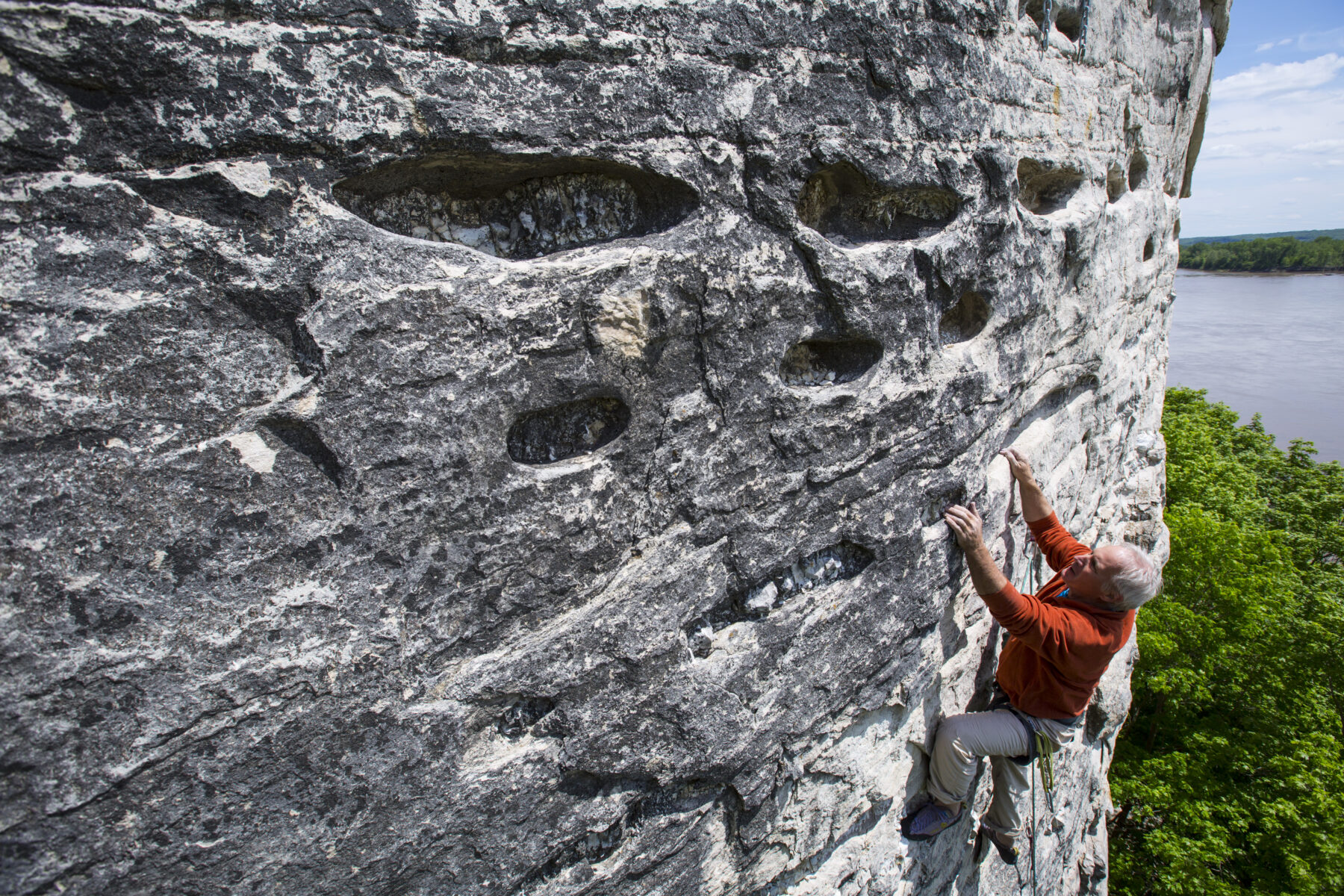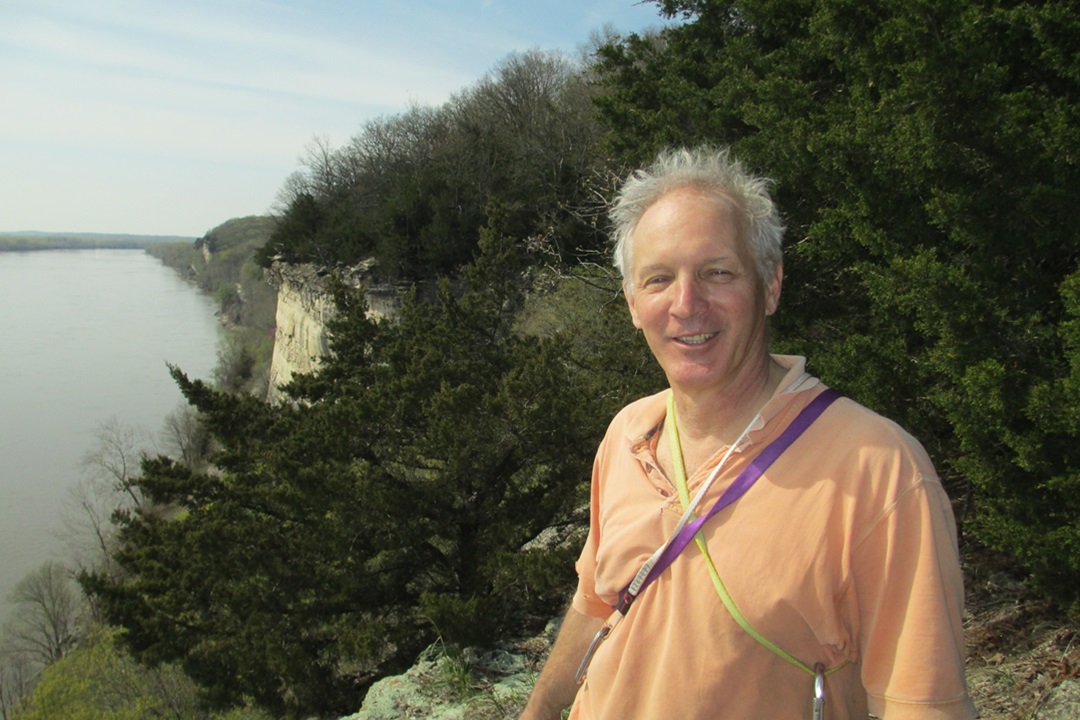In 1969, when Jim Karpowicz was 13 years old, he read a biography of John Harlin, an alpinist who fell to his death just a few years earlier while attempting an ascent of Eiger, a mountain in the Swiss Alps.
“I was hooked,” said Karpowicz, who grew up in St. Louis. “When the opportunity [to go climbing] presented itself, I was preloaded. Ready to go.”
The problem was, at that time there was not much of an established local climbing community. “In the St. Louis area, there were like maybe 20 people who were climbing,” he said.
But thanks to Karpowicz and other early climbers’ efforts in establishing routes, more people in search of an adventure grabbed hold of the rock faces around Missouri.
These days in Missouri, there are hundreds of climbing routes, a countless number of boulder problems, and a dozen or so climbing gyms, which mean there are options for beginners and advanced climbers both.
Karpowicz was so fond of Providence, a climbing area in Columbia near the Katy Trail, that he purchased a home just five minutes away.
To get a better sense of how Missouri climbing evolved and became a formidable scene, we interviewed Karpowicz, who at age 68 continues to spend hours climbing at least a few times each week.
What was the Missouri climbing scene like when you first started climbing?
When I first got into it, there was no Missouri scene. It was me and my friend Dan Smith, and there was a group of older guys from the St. Louis Mountain Club. In that club was Bob Mooers, who created Mooers Alpine, which became the Alpine Shop.
We started climbing with bowlines around our waist and that evolved into tying what we called Swiss Seats, which was a little harness that you would make out of webbing.
Even in Missouri, there has always been this kind of weird connection to alpine climbing. I can remember guys climbing in knickers, and they wore these old kletterschuhes. [Editor’s note: These early German climbing shoes were made of suede with laces, metal eyeholes, and rubber soles.]
Do you see something as having been a tipping point to where the scene really took off?
Probably the biggest difference was the development of sport climbing, where you could develop a cliff by rappelling down and placing bolts instead of placing things on the lead.
There was a strong sort of ethical quest to do everything from the ground up and lead everything with trad protection. There were no bolts. We didn’t know how to put in bolts.
I think that’s the big change. When sport climbing came in and people were starting to bolt things in and repelled, all of a sudden it got safer, more accessible.
The second stage would have to be the opening of the inside gyms, which was of course later, but in the past 20 years, that has really brought a lot of people out to the crags.
What do you think makes Missouri unique as compared to other states or just a good destination for climbing?
I’m not sure I would call it a destination, because if you live in Colorado or Arkansas or southern Illinois, you don’t necessarily want to drive to Missouri to go climbing, but it is home.
I have got crags — good crags — that are five minutes from my house, and I think it’s that ease of access.
Now you have got Rockwoods Reservation developing in St. Louis. I know St. Louis climbers have for years been driving down to southern Illinois, and now you can just go out and do crags in an afternoon at Rockwoods.

Karpowicz on Flying Meat ( 5.9+) at Andromeda climbing area in Missouri. (Andrew Burr)
Do you have a favorite place to climb in Missouri?
Probably Providence. Climbing on the Katy Trail is important to me, and there’s quite a bit of climbing. It’s the best climbing in the state.
There’s a section between Rocheport and Jefferson City, which is about 60 miles of cliff that has just got incredible lines on it.
Of course, the access issues there are a little bit sketchy. Some of it is within the right of way of the Katy Trail. Some of it’s not. We have permission from some private landowners to climb on their property. Some of them, we don’t. So, it’s not as clear cut as Rockwoods or Elephant Rocks, where climbing is just totally open and permitted. We still kind of keep a low profile, but the Katy Trail climbing is certainly my favorite place to be.
What about it makes it the best place in Missouri?
The rock is certainly weird. It’s like this Burlington limestone, but the routes are big and overlook the Missouri River, which is fantastic. There’s an area between Rocheport and Huntsdale that we call the Andromeda Sprain area, and it’s just gorgeous. You look over your shoulder, and you have got the Missouri River underneath you.
What advice would you give to someone who’s interested in climbing here in Missouri?
Go outside. Get out of the gym. So many young climbers I talk to in the gym are like, “Oh, I don’t climb outside” or “I don’t do trad,” and that’s just ridiculous, because if you don’t do trad, you’re not going to climb in Yosemite. You’re not going to climb in any of the great ranges in the world.
I think that they think there’s this sort of magic, ancient art of trad climbing that somebody needs to bestow on you. Just go out, buy some [camming devices], stick them in the rock, make mistakes, fall. You’ll live. We did.
Author: Eric Berger is a regular contributor to Terrain Magazine.
Top Image: Jim Karpowicz in Boone County, Missouri. (Andrew Burr)


Leave A Comment